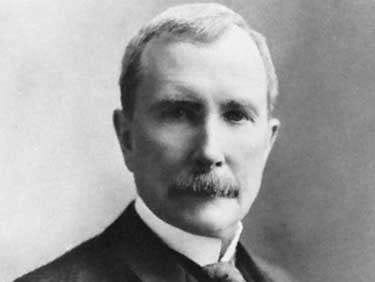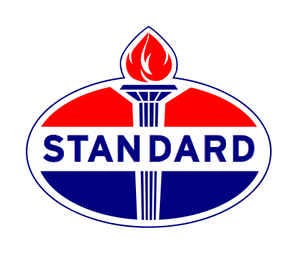The arrival of petroleum; Rockefeller, and the lessons he taught us
Looking at entrepreneurship & innovation through biographies
Before the arrival of petroleum there were a number of different fuels that could be used for light and power. Coal became an important fuel in industry for steam engines, but houses still cooked with wood and lit their houses with candles or whale oil. A large whaling industry existed in many parts of the world primarily to secure oil for lighting (Creighton 1995). However, whale oil was expensive and only affordable by the well to do of society, particularly in 1850 where stocks dwindled due to being hunted almost to the point of extinction, the price went up dramatically (Chernow 1998) – a hint and forerunner into the future petroleum oil scenario. This created an impetus to find another source of fuel for lighting.
In the late 1840s and early 1850s there were a number of people working on extracting oils from naturally occurring bituminous tars, coal, oil shale, and crude oil. In 1846 a Canadian geologist Abraham Gesner announced and demonstrated that he could distill a clear thin fluid from coal which made an excellent lamp oil he called kerosene. As the cost of dry distillation proved too high, Gesner looked at extracting kerosene from albertite that occurs in natural bituminous tar. After some difficulties in finding a place to mine the material due to coal mining companies having the mining rights, Gesner moved to Long Island in 1854. With the backing of a group of businessmen they formed the North American Gas Light Company. Gesner later commenced distilling kerosene from bituminous coal and oil shale around the Boston area (Loris 2003).
In 1848 a Scottish chemist James Young experimented with oil seeping from a coal mine as a source of lubricating and illuminating oil. Young expanded production to extracting what he called paraffin oil from locally mined torbanite, shale, and bituminous coal. In 1851 Samuel Martin Kier distilled oil from crude oil which he called carbon oil, selling it as lamp oil. Across in Europe Ignacy Lukasiewicz, a Polish pharmacist in Lvov and used local seep oil to experiment with different kerosene distillation techniques, trying to improve upon Gesner’s techniques. Doctors at his hospital needed a strong light for an emergency operation and called him to assist with the lighting. The lamps performed extremely well and Lukasiewicz seeing the potential of this product moved to the Gorlice region of Poland in 1854 sinking a number of wells over the following decade. He set up a refinery near Jasto in 1859.
A Professor Benjamin Silliman Jr. was commissioned by George Bissell and Jonathan Eveleth, who were mining oil in Pennsylvania and selling it for medicinal purposes. They were able to extract kerosene from crude oil in 1855 with much higher yields than coal or bituminous tar. With the news that crude oil could make a number of high value products, Bissell and Eveleth formed the Pennsylvania Rock Company (later known as Seneca Oil) and commissioned Edward Drake to investigate the possibility of oil deposits in Titusville, Pennsylvania. In 1859 Drake with the help of a salt driller constructed a 30 ft high derrick and drilled seventy feet into the ground and stuck oil (Pusateri 1988). This spurred an oil rush with many speculators coming to the region to prospect for oil. There were so many speculators drilling for oil that no one could make a profit with Drake himself dying in poverty. It was an unexpected event, the American Civil War that eventually drove prices up making it worthwhile to go into the crude oil drilling business. Within a decade the oil business had expanded to more than 5 million barrels with the majority of oil being converted to kerosene for homes and later industry, paraffin for candles, and tar for paving, displacing the use of whale oil which declined rapidly as an industry (Starbuck 1989).
John D. Rockefeller was born in Richmond, New York in 1810 to a meager family. In his teens, Rockefeller took great interest in bookkeeping and was a thrifty and devout Baptist who devoted part of his salary each month to the church. His first job was at a produce company where he worked long hours. In 1859 Rockefeller set up his own produce company with Maurice B. Clark and the business steadily grew and returned a profit each year (Segall 2001). In 1863 during the American Civil War, Clark and Rockefeller ventured into the oil refining business with Samuel Andrews, a chemist and inventor[1]. During the Civil War Rockefeller bought out Maurice Clark and his brother’s shares in the company by auction and renamed the company Rockefeller & Andrews. This enabled Rockefeller to position himself to take advantage of the growing demand for fuel with the westward push of the railroads. Rockefeller borrowed heavily, and obtained $100,000 from Stephen V. Harkness on the condition that Henry Morrison Flagler[2] is made a partner. The company was renamed Rockefeller, Andrews & Flagler. With Flagler on board Rockefeller was able to quickly adapt to changing markets (Segall 2001, P. 32). Flagler introduced rebates to customers in order to strengthen the company’s position against competitors, while Rockefeller looked at ways to become more production efficient. One of these schemes was to vertically integrate into the barrel production business (Schweikart & Doti 2010). As this business grew Rockefeller brought in his brother William and renamed the company, the Standard Oil Company.
Rockefeller focused on finding as many potential uses for crude oil by-products as possible by bringing in outside chemists and eliminating waste during the refining process. This had the effect of pushing prices for kerosene so low that coal and other crude oil extractors had problems surviving. The whaling industry floundered and the concept of electricity for lighting was ignored during this time. Standard oil became one of the most efficient refineries in the industry.
Early on Rockefeller had become one of the largest shippers of product on the railroads. The railroads were fiercely competing for business. In an attempt to form a cartel, Standard Oil with a few other refiners formed the Southern Improvement Company. The scheme involved the railroad companies raising freight rates and paying back rebates to Southern Investment Company, both on their own and competitors’ shipments. Independent competitors and consumers found out about the scheme which led to protests, boycotts and even vandalism of company property. The Pennsylvania Legislature revoked the company’s charter. Rockefeller admitted his mistake and abandoned efforts to create a freight cartel.
Rockefeller turned his attention to expanding the company and went about acquiring competing refiners, taking on their managers and employees, improving the efficiencies of the firm’s operations, and passing on discounts to their customers. Where possible, Rockefeller exchanged shares for the purchase of his competitors preferring to save the cash for further expansion. By the late 1870s Standard oil controlled between 80-90% of the kerosene market and owned the majority of refiners. This gave Rockefeller an enormous bargaining chip over the railroads and he insisted on rebates at a time when the railroads were already within a round of price wars.
Rockefeller planned for the use of pipelines to transport oil and began to acquire land to do this. The Pennsylvania Railroad seeing the potential threat of Standard’s incursion into the transport business began buying up refiners. Rockefeller retaliated by holding back shipments and using alternative railroads with the effect of dramatically reducing freight charges. The Pennsylvania Railroad Company eventually gave in and sold all its oil interests to Standard Oil. In 1879 the Commonwealth of Pennsylvania indicted Rockefeller on charges of monopoly, starting a number of court proceedings against the company for monopolistic practices.
Standard oil had a number of oil fields, its own tankers, was constructing pipelines, and building networks of dealers and overseas subsidiaries. Standard used this infrastructure to keep oil prices low enough to prevent potential competitors entering the market[3], and be affordable to the average household, with the price of kerosene dropping more than 75% during the life of Standard Oil.
Standard Oil faced a number of challenges. New oil finds in other countries were diluting Standard Oil’s international dominance. The Russians discovered oil in Baku, Central Asia that was of higher quality and cheaper to extract. As Russian production increased Standard Oil’s market share declined to just over 50% of the world market. The Russian fields were also more centrally located for the European and Asian markets. Robert Nobel, brother of Alfred Nobel decided to try the oil industry and went to Baku to develop oil wells and refining operations financed by the Rothschilds. Additional fields were discovered in Burma and Java and the electric light bulb was finding interest as an alternative to kerosene for lighting. Nevertheless, Rockefeller retaliated building more tankers and sold oil cheaper than what was coming out of Baku. Standard Oil was able to win back some of its international market share.
Back in the United States Standard Oil was operating across a number of states with a myriad of companies which was unruly to manage and control. Rockefeller’s lawyers devised a trust which could take ownership of the equities of all the companies. This came into being by 1882 where all assets were under the control of the trust with Rockefeller as one of the nine trustees. As the largest business entity in the world Standard Oil came under criticism of competitors, politicians, and the public and under the scrutiny of anti-trust laws. Standard oil in 1899 restructured again under a holding company in New Jersey capitalized at USD $110 Million.
During the 1890s the company expanded into natural gas production and bought fields in Ohio, Indiana, and West Virginia as the Pennsylvania fields began to dry out. Standard also began selling gasoline for automobiles which until then was considered a waste product. Rockefeller also moved into other industries buying out iron ore interests. Rockefeller formally retired in 1902, but remained president of the corporation. Rockefeller became very weary of all the criticisms of himself and Standard Oil and consequently made himself more accessible to the public. In 1911 the Supreme Court of the United States found Standard Oil in violation of the Sherman Anti-Trust Act and ruled that the company originated in illegal monopoly practices and ordered it to be broken up into 34 separate companies. Today some of these companies have developed into very successful corporations in their own right which included Conoco, ConocoPhillips, Amoco (now part of BP), Mobil (now ExxonMobil), Sohio (now part of BP), Chevron, and Pennzoil. Rockefeller kept his stock in all the companies at the time of breakup with increased his personal wealth to almost USD $1 Billion.
Rockefeller was criticized by competitors, the public and the media all throughout his career for being cruel, ruthless, pitiless, and engaging in unfair, heavy handed and monopolistic practices to get his own way and had plenty of enemies. This is paradoxical to the espoused philosophies of Rockefeller who claimed it was never about the money, but giving a fair deal to the poor working man by providing them with the best quality and cheapest product (Nevins 1953). Although critics claim he sanitized his memoirs published in 1908 as being contrary to his real business methods (Segall 2001, P. 91), it must not be forgotten that he contributed 10% of his income to the church and became one of the greatest philanthropists of all time.
There are a number of lessons that can be learnt from the history of Standard Oil. Opportunities often come from a person one knows within or outside their business network as was the case with Rockefeller’s church friend Samuel Andrews. The start-up of a business is extremely vital to the future trajectory of the business. This is a critical time. The decisions made and directions taken in the early stages will usually influence the formation of future strategies. It is also important that the early formation activities be led in total competence and with skill. Rockefeller’s assistance came from Andrews on the technical aspects and Flagler on marketing and strategy were vital to success. A company needs to be well managed in the growth stage. Company success is influenced strongly by a founder’s drive, passion, vision and far-sighted planning. The culture of the company is also heavily influenced by the founder and even reflected in the companies chosen strategies. Rockefeller was considered to be ruthless and many of the strategies and actions he took reflected this.
In the Standard Oil case, controlling a limited resource and developing a supply chain that gave an advantage over other producers was the key to their position within the competitive environment. Standard Oil sought to control a resource through owning as many wells as possible, being as efficient as possible, and gaining advantage over the supply chain to the point where the price of kerosene was low enough to act as a barrier to entry to potential competitors. Rockefeller also realized the link between research and development and gaining more products that would increase revenues.
The start-up of Standard Oil was at a time where the main product substitute was whale oil which was much more expensive than kerosene. Standard oil also started before electrical lighting was able to gain a foothold in the market. During the growth stage of Standard Oil, the automobile industry began to emerge providing a new market for the company. Finally at the time of start-up the technology required existed to make the venture viable. There is one final lesson for firms of the future that the Standard Oil story can provide. Just because a firm gives money away to charity or works on community projects doesn’t always go into support the company’s image if it is not seen to be ethical in its business dealings.
As a footnote, it could be argued that Microsoft has achieved a position of market dominance in the computer industry that Standard Oil achieved in the petroleum industry. The question is here is whether the dominance of a single company over any single industry is healthy. Although there are alternatives to Microsoft products, Windows has become the default standard and their products are needed so that one can be compatible with the rest of the world.
However, IBM was once in a similar position until “two” impetuous “boys” got the better of them with their operating system. So, there is also the possibility that current evolution of the market and merging of various industries like the computing, photography, and communications will create new winners and losers – a natural guard against monopoly just like a body has an immune system against disease.
The era of the cloud may change what we know today. Just as Standard Oil once dominated and was dismantled by regulation, the market system itself may be self-regulating through the power of evolution. Dec, Wang and now Kodak may all be victims to the grand scheme of evolution. Will Microsoft also learn that nothing is forever?
Originally published in OVI Magazine 10th September 2012
You can subscribe for free emails of future articles here:
Notes and References
Chernow, R. (1998). Titan: The Life of John D. Rockefeller, New York, Random House.
Creighton, M.S. (1995). Rites and Passages: The Experience of American Whaling 1830-1870, Cambridge, Cambridge University Press.
Loris, R. S. (2003). A Heritage of Light, Lamps and lighting in the Early Canadian Home, Toronto, University of Toronto Press.
Nevins, A. (1953). Study in Power: John D. Rockefeller, Industrialist and Philanthropist, Vol. 1, New York, Charles Scribner’s Sons.
Pusateri, C.J. (1988). A History of American Business, 2nd Edition, Wheeling, Ill.,Harlan Davidson Inc.
Schweikart, L. & Doti, L.P. (2010). American Entrepreneur, New York, AMACON.
Segall, G. (2001). John D. Rockefeller: Anointed with Oil, Oxford, Oxford University Press.
Starbuck, A. (1989). History of the American Whale Industry, Secaucus, NJ., Castle Books.
[1] Samuel Andrews immigrated to the United States from England and had experience in shale oil production in the newly discovered fields of Western Pennsylvania. Andrews was the person who approached Rockefeller about the oil business. Andrews was a good creative engineer who was able to develop the chemical processes of fractional distillation required for isolating the different fractions or chemicals from crude oil.
[2] Henry Flagler is credited for his marketing strategies and schemes that could capitalize on Andrew’s technical knowledge.
[3] Standard Oil’s major weapons against its competitors were low pricing through economies of scale, freight rebates and differential pricing to customers.






